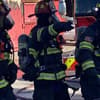Guidelines for Chemical Sedation PDF
Document Details

Uploaded by Firelaz
Coral Springs-Parkland Fire Department
Tags
Summary
This document outlines guidelines for chemical sedation, a supplementary measure used in emergency situations involving violent or combative patients. It details pre-sedation considerations, including verbal de-escalation, patient assessment, and equipment preparation. Post-sedation procedures are also described, including ongoing patient monitoring and access for treatment.
Full Transcript
Guidelines for Chemical Sedation Chemical Sedation Policy Statement: Chemical sedation may be employed as a supplementary measure to physical restraint in instances where individuals exhibit violent or combative behavior, thereby posing a threat to themselves or emergency medical services (EMS) pers...
Guidelines for Chemical Sedation Chemical Sedation Policy Statement: Chemical sedation may be employed as a supplementary measure to physical restraint in instances where individuals exhibit violent or combative behavior, thereby posing a threat to themselves or emergency medical services (EMS) personnel. Pre-Sedation Considerations: 1. Chemical sedation should be a last resort, enacted only after non-physical measures (e.g., verbal de-escalation) prove ineffective. The EMS officer present will make this decision independently of law enforcement influence. 2. In situations where physical access to the patient for vital sign assessment is unsafe, perform and document a visual examination of the patient's skin color and condition, respiratory rate, and effort, and conduct a head-to-toe assessment. 3. All Advanced Life Support (ALS) equipment must be ready for use. This includes, but is not limited to, the Zoll Monitor, jump bag, stretcher, and airway management tools. 4. Estimate the patient’s weight using professional judgment and consensus among the crew. a. Employ the Handtevy application and paramedic (PM) judgment to assist in weight estimation using the patient’s estimated height. Alternatively, use the weight listed on the patient’s driver’s license (if available). b. Using the Handtevy application, the weight is listed in pounds and kilograms, and all calculations are performed using kilograms. Announce the patient’s weight in pounds, ensure crew agreement. There should be no need to perform a medication calculation once the correct size is selected on the app. 5. Verify any medication dosage intended for chemical sedation with another crew member before administration. Post-Sedation Procedures: 1. Once sedation is achieved and the patient's agitation has subsided, conduct a comprehensive ALS assessment. This should include ECG, preferred IV access, capnography (EtCO2), pulse oximetry (SpO2), blood glucose level (BGL), temperature, and blood pressure monitoring. 2. Maintain ongoing visual supervision and continuous monitoring of the patient’s vital signs. 3. Secure the patient to the stretcher, ensuring that they are positioned to allow for both access and any necessary treatment. 4. Never place a restrained patient in a prone position. 5. An EMS medical director is always available for consultation by phone 24/7/365 if needed.